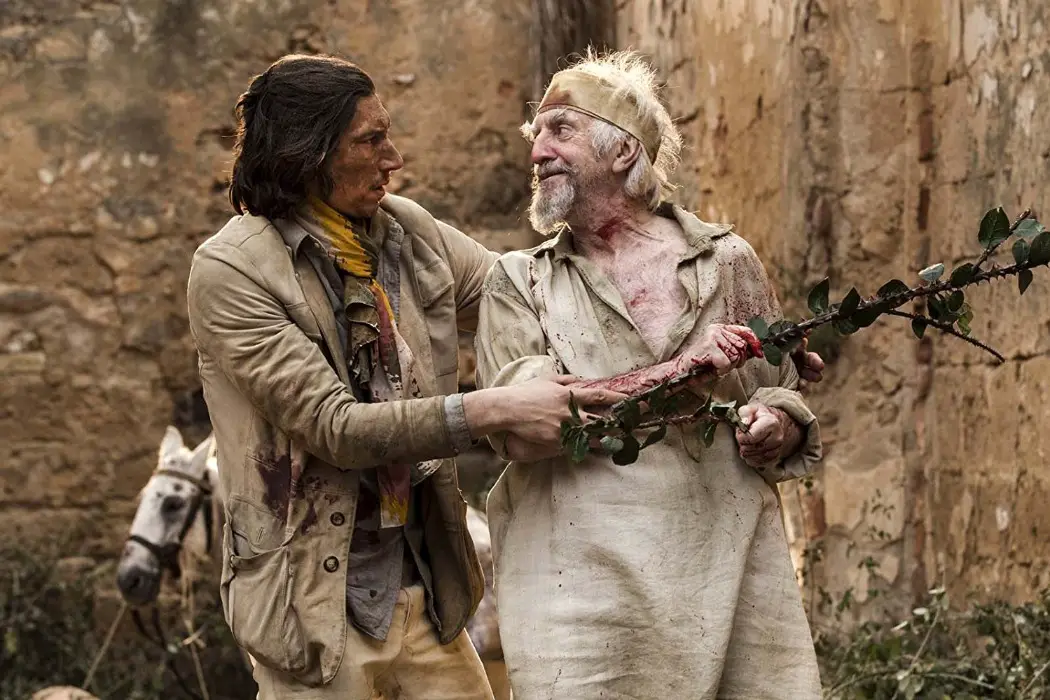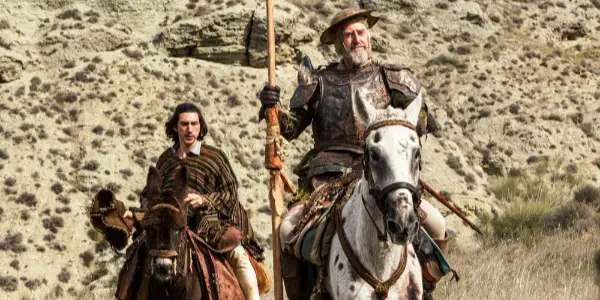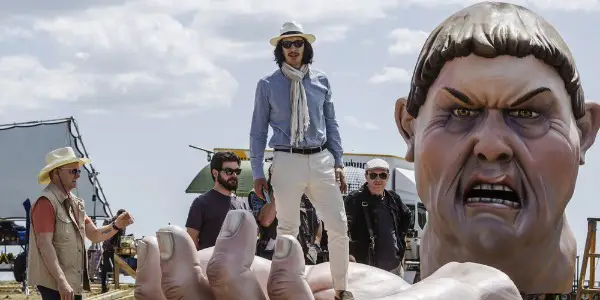THE MAN WHO KILLED DON QUIXOTE: A Mean Spirited Reimagining Of A Literary Classic

Alistair is a 25 year old writer based in Cambridge.…
Terry Gilliam is tired of hearing about the exhaustive production process of his latest film, The Man Who Killed Don Quixote. Initially conceived 29 years ago, the film has achieved somewhat mythical status due to all the aborted attempts to bring it to the screen – one of which was documented in the 2002 documentary Lost in La Mancha.
Although this has been such a long gestating labour of love for the legendary director, the simple reason he’s tired of hearing about the production is because the film as it stands today is far different to the one he imagined all those years ago.
Quixote gone Meta
Originally a time travelling period piece, his Don Quixote take today stands as a metatextual commentary on creativity and artistic expression, blurring the lines between reality and period fantasy. There are numerous nods to the finer details of Miguel de Cervantes’ 17th century literary work throughout, updated for a more cynical modern age where pessimism has displaced wonderment. Unfortunately, seeing this story through an incredulous postmodern lens is what proves to be the film’s downfall; instead of being an ode to dreamers and optimists, Gilliam’s latest has a mean spirited undercurrent that proves hard for the film to shake off.
Adam Driver stars as Tony Grisoni, a hotshot advertising director who has long abandoned his filmmaking career to helm soulless advertising campaigns. Filming a Don Quixote themed commercial in Spain, he discovers a copy of a film he made as a student a decade earlier, a black and white reimagining of the Don Quixote story. He discovers that the village where he made the film is just a short drive away, and heads over there – only to discover Javier, the shoemaker he cast in the leading role (Jonathan Pryce), now believes he is the real Don Quixote, and is living a life in captivity by an elderly woman using him as a tourist attraction.

With Tony’s unwilling help, he escapes, and after Tony unintentionally becomes a witness to a fire Javier accidentally started whilst making his escape, he flees with Javier on horseback to take part in a number of mythical quests. The only problem? Javier believes Tony to be Quixote’s long suffering sidekick Sancho.
In many ways, Gilliam has faithfully stuck to the spirit of the source material, adapting it to modern sensibilities in the only manner that’s tangible. Quixote’s visions of grandeur and Sancho’s down to earth pragmatism are here adapted to their logical extremes; Javier has severe mental health issues that has led him to believe he is the iconic character, whereas Tony has become so cynical because of his career in advertising, his downtrodden responses to the ludicrous scenarios feel believable. Gilliam has made headlines for a number of highly un-PC comments in recent years, which can be largely forgiven due to the tendency for older people to become “out of touch”, and yet there is still something distasteful about the interpretation of Quixote here that can’t be shaken off as easily.
Cynically Fantastic or Fantastically Cynical?
The character has, throughout all previous iterations, suffered from delusions due to a reluctance to see the world as it actually is. Yet with Gilliam’s adaptation frequently diagnosing the Quixote surrogate with severe mental health issues, a fantastical comic character becomes something exponentially more tragic – and the film still treats him as the same deluded figure of fun that we’ve come to know in the source material. Elsewhere, Gilliam has attempted to find manners in which to update more fanciful sections of prose from Miguel de Cervantes’ work, namely paying lip service to his wondrous portrayals of Islamic culture. How does he do this? If you guessed “make numerous jokes equating Muslims with suicide bombers”, then, unfortunately, you’d be correct.
Seeing Gilliam at a Q&A after the screening cracking jokes from a strongly anti-Trump and anti-Brexit perspective just makes finding humour from that same Islamophobic well feel all the more jarring. He did suggest that a scene where Tony finds Arabic writing at a home the pair stay at, assuming that the owners are suicide bombers with the intent to kill them, is the first sign that Tony is beginning to suffer from the same delusions as Javier.

This would almost make sense, were it not for the later jokes where Javier mistakes a group of goats for practicing Muslims, and crowds reacting in fright to bearded Muslim women (long story). Gilliam does, of course, make jokes about a wide swathe of religious ideologies, but it’s only the jokes concerning Islam and those practicing it where he leans into broad, cartoonish stereotypes, that can hardly be justified on the deteriorating mental health of the central characters whose lens we are seeing this through.
Gilliam’s sensibilities do ensure a distinctive adaptation of this material; there are echoes of Time Bandits in the medieval stylings of the story, as well as a hint of Fear and Loathing in Las Vegas, as the depiction of reality becomes increasingly skewed due to the unreliable narrators we follow. Nobody but Terry Gilliam could have made this film – for better or for worse. He can capture the breathtaking wonder of the Spanish countryside, and even rivals Fellini with his later portrayals of wealthy extravagance. There’s just not substantial heart to compliment his fanciful aesthetics, with the film feeling depressingly cynical even as the characters let go of their cynicism and give in to viewing the world with a Quixotic sense of wonder.
The Man Who Killed Don Quixote: Conclusion
Keeping with Gilliam’s wishes, I’ve tried to avoid referencing this film’s production process as much as possible here, largely because the film doesn’t feel like such a long gestating labour of love. Instead, after failing to get the film out of production hell for so many years, it’s no surprise his Don Quixote feels world weary and cynical, viewing the fantastical elements as nothing more than mere kitsch. It’s hard not to wish we were catching a glimpse of his original take on the classic tale.
Have you seen The Man Who Killed Don Quixote? Tell us your thoughts in the comments below!
The Man Who Killed Don Quixote is still awaiting UK and US distributors due to legal issues, but all international release dates can be found here.
Does content like this matter to you?
Become a Member and support film journalism. Unlock access to all of Film Inquiry`s great articles. Join a community of like-minded readers who are passionate about cinema - get access to our private members Network, give back to independent filmmakers, and more.
Alistair is a 25 year old writer based in Cambridge. He has been writing about film since the start of 2014, and in addition to Film Inquiry, regularly contributes to Gay Essential and The Digital Fix, with additional bylines in Film Stories, the BFI and Vague Visages. Because of his work for Film Inquiry, he is a recognised member of GALECA, the Gay & Lesbian Entertainment Critics' Association.













